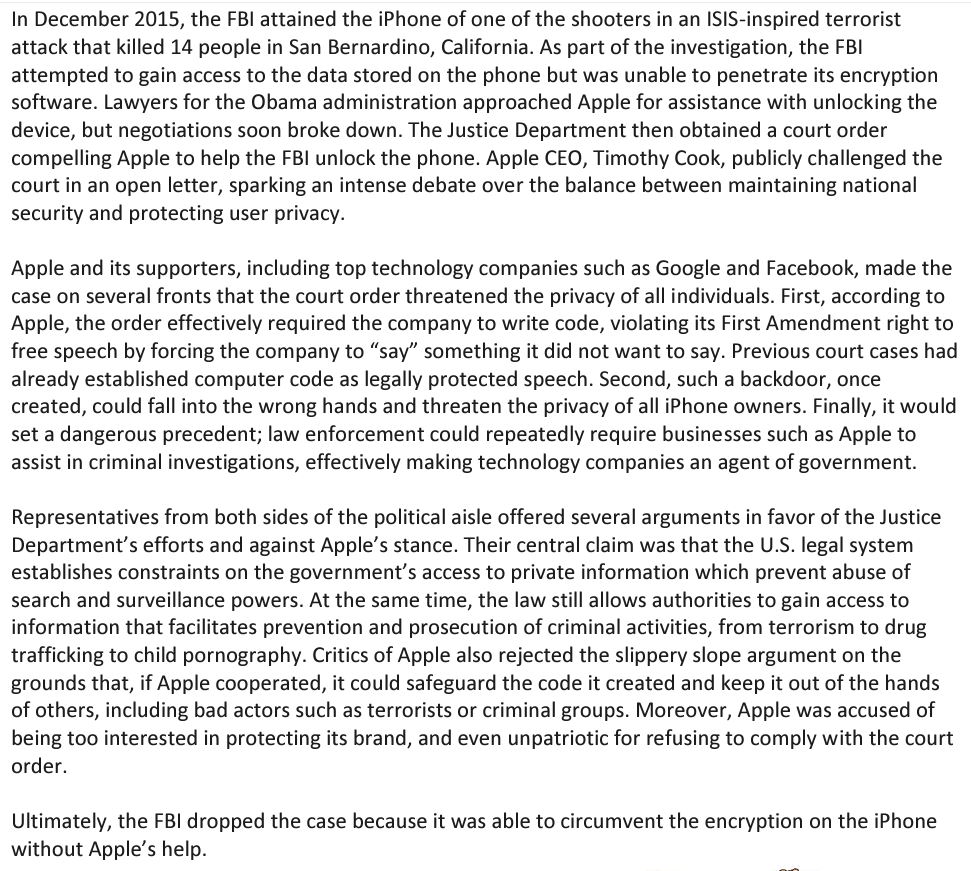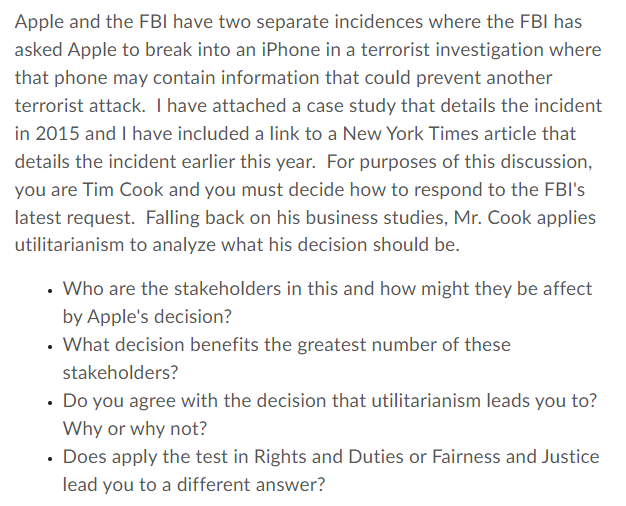Answered step by step
Verified Expert Solution
Question
1 Approved Answer
In December 2015, the FBI attained the iPhone of one of the shooters in an ISIS-inspired terrorist attack that killed 14 people in San


In December 2015, the FBI attained the iPhone of one of the shooters in an ISIS-inspired terrorist attack that killed 14 people in San Bernardino, California. As part of the investigation, the FBI attempted to gain access to the data stored on the phone but was unable to penetrate its encryption software. Lawyers for the Obama administration approached Apple for assistance with unlocking the device, but negotiations soon broke down. The Justice Department then obtained a court order compelling Apple to help the FBI unlock the phone. Apple CEO, Timothy Cook, publicly challenged the court in an open letter, sparking an intense debate over the balance between maintaining national security and protecting user privacy. Apple and its supporters, including top technology companies such as Google and Facebook, made the case on several fronts that the court order threatened the privacy of all individuals. First, according to Apple, the order effectively required the company to write code, violating its First Amendment right to free speech by forcing the company to "say" something it did not want to say. Previous court cases had already established computer code as legally protected speech. Second, such a backdoor, once created, could fall into the wrong hands and threaten the privacy of all iPhone owners. Finally, it would set a dangerous precedent; law enforcement could repeatedly require businesses such as Apple to assist in criminal investigations, effectively making technology companies an agent of government. Representatives from both sides of the political aisle offered several arguments in favor of the Justice Department's efforts and against Apple's stance. Their central claim was that the U.S. legal system establishes constraints on the government's access to private information which prevent abuse of search and surveillance powers. At the same time, the law still allows authorities to gain access to information that facilitates prevention and prosecution of criminal activities, from terrorism to drug trafficking to child pornography. Critics of Apple also rejected the slippery slope argument on the grounds that, if Apple cooperated, it could safeguard the code it created and keep it out of the hands of others, including bad actors such as terrorists or criminal groups. Moreover, Apple was accused of being too interested in protecting its brand, and even unpatriotic for refusing to comply with the court order. Ultimately, the FBI dropped the case because it was able to circumvent the encryption on the iPhone without Apple's help. Apple and the FBI have two separate incidences where the FBI has asked Apple to break into an iPhone in a terrorist investigation where that phone may contain information that could prevent another terrorist attack. I have attached a case study that details the incident in 2015 and I have included a link to a New York Times article that details the incident earlier this year. For purposes of this discussion, you are Tim Cook and you must decide how to respond to the FBI's latest request. Falling back on his business studies, Mr. Cook applies utilitarianism to analyze what his decision should be. Who are the stakeholders in this and how might they be affect by Apple's decision? What decision benefits the greatest number of these stakeholders? Do you agree with the decision that utilitarianism leads you to? Why or why not? Does apply the test in Rights and Duties or Fairness and Justice lead you to a different answer?
Step by Step Solution
There are 3 Steps involved in it
Step: 1
Answer Stakeholders in this scenario include 1 Apple As a technology company Apple has a vested interest in maintaining the privacy and security of it...
Get Instant Access to Expert-Tailored Solutions
See step-by-step solutions with expert insights and AI powered tools for academic success
Step: 2

Step: 3

Ace Your Homework with AI
Get the answers you need in no time with our AI-driven, step-by-step assistance
Get Started


